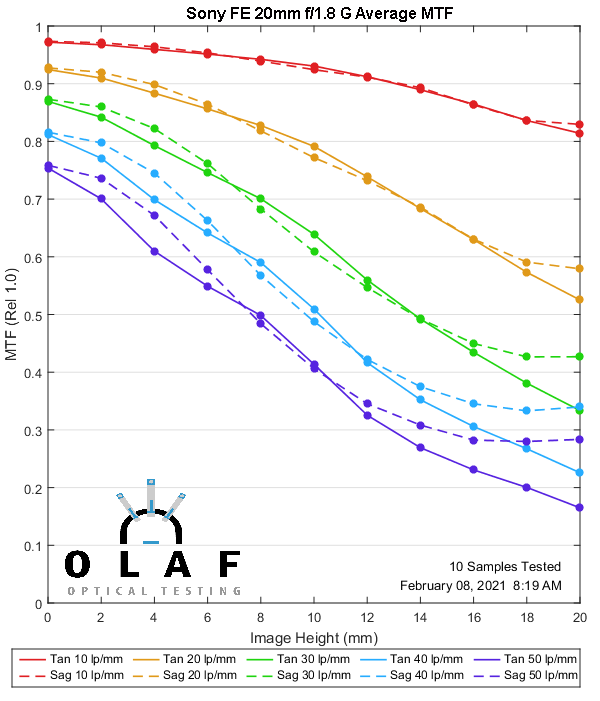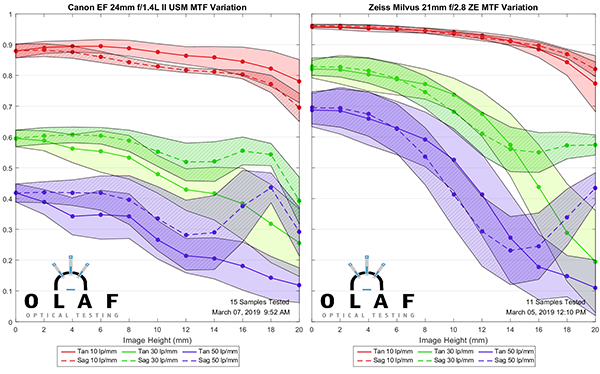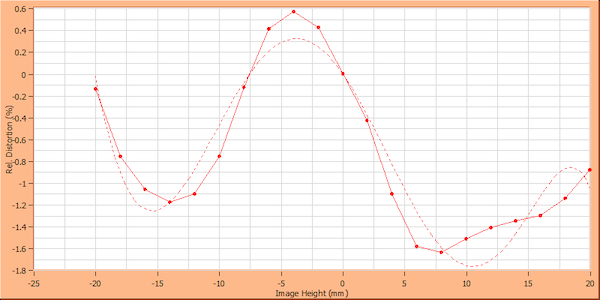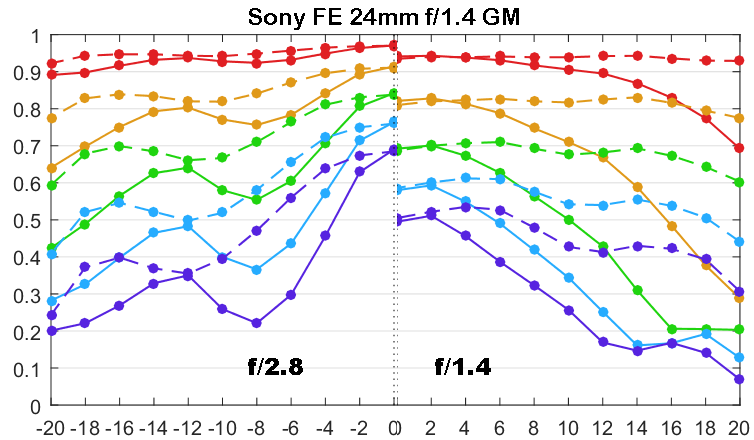Lenses and Optics
Sony FE 20mm f/1.8 G Optical Tests

I haven’t published much optical testing in the last year for many reasons; some obvious, some not. But published or not, we still test things, and occasionally something comes up that I think I need to write up. The Sony FE 20mm f/1.8 G is one of those things.
As wide-angle primes go, it’s reasonably priced at $800. My hope is it’s at least as good at f/1.8 as the more expensive f/1.4 primes. But the obvious comparison is the Sigma 20mm f/1.4 DG HSM Art. The Sony 24mm f/1.4 GM might be a logical comparison, but 20mm is significantly wider than 24mm, and the GM is almost twice the price of the 20mm f/1.8.
MTF Results
This is actually rather spectacular. The center resolution is phenomenal. (Remember, when comparing to an f/1.4 lens, being tested at f/1.8 gives an advantage, but even so, it’s phenomenal.) Resolution drops off slowly and steadily towards the edges. Most amazingly, there is almost no separation between the sagittal and tangential MTF, which means there is almost no astigmatism or lateral color.

Lensrentals.com, 2021
There is some variation, both in overall sharpness (the variation you see near the center of the graph) and in side-to-side variation (the increase in variation you see as you go away from the center).

Lensrentals.com, 2021
This isn’t awful, but it is a little worse than average for a wide-aperture prime. Here are a couple of ‘good variance’ wide primes; the Canon 24mm f/1.4L II and the Zeiss Milvus 21mm f/2.8 for comparison. Notice the Sony above is significantly sharper than the Canon, and math says higher resolution increases variance a bit.

Lensrentals.com, 2021
Field Curvature and Distortion
The field curvature here is remarkably flat for a wide-angle lens in both the sagittal and tangential planes. This is not an easy thing to accomplish. The flat field with little astigmatism makes it a superior lens for landscape, astro, and architectural work. It is a little bit softer in the outer 1/4 of the image, but that would, of course, improve as you stop down a bit.

Lensrentals.com, 2021
Measuring distortion in Sony lenses often leads to further discussion. Measuring just the lens on the bench (optics only, no camera involved) shows about 1.9% distortion in a mustache distribution.

Lensrentals.com, 2021. This sample is slightly tilted, but you can see the mustache pattern.
Tests using Imatest or other image computer target analysis (using a Sony camera) show a similar distortion pattern, but a much lower amount (0.7% or 0.8%), even with distortion correction turned off in raw conversion. I don’t like modifying raw files, so I mention it, but most people don’t care.
A Couple of Comparisons
I said earlier that this is a surprisingly good lens. Here’s a couple of comparisons to help visualize that.
Sony FE 20mm f/1.8 G vs Sigma 20mm f/1.4 Art
The Sigma has the advantage of a wider aperture and comes at an equivalent price.

The Sigma will sharpen up a bit at f/1.8 compared to the f/1.4 it’s being tested at. However, the Sony will still be significantly sharper in the center of the image and has far less astigmatism-like separation between the sagittal and tangential fields. In other words, unless you need f/1.4, the Sony is better.
Sony FE 20mm f/1.8 G vs Nikkor AF-S 20mm f1.8G ED
This isn’t really a fair comparison, the Nikkor is a full generation older than the Sony, but it is a good example of how far wide-angle lens design has progressed over the last 7-8 years. In this one area, newer is clearly better.

Lensrentals.com, 2021
Sony FE 20mm f/1.8 G vs Sony FE 24mm f/1.4 GM
This is probably not a really useful comparison; the 24mm is twice the price, a bit wider aperture, and not nearly as wide as the 20mm. Still, I think some people would be deciding between one and the other, or perhaps deciding that their zoom might cover 24mm, and the 2omm serve as a reasonably wide aperture prime.

Lensrentals.com, 2021
As discussed above, the 24mm will be sharper stopped down a bit. I didn’t have time to run a whole set of lenses stopped down, but did one copy of the 24mm f/1.4 at f/2.8 to demonstrate the change between wide open and stopped down. Even at f/2.8, though, the 24mm isn’t resolving much (if any) better than the 20mm f/1.8 at f/1.8. And it still has more sagittal-tangential separation.

lensrentals.com, 2021
So What Did I Learn Today?
I keep saying Sony lives out there on the cutting edge of technology, always going for the home run shot. Sometimes that results in a swing-and-a-miss, but when it works, everyone leaves their seats. The FE 20mm f/1.8 is a home run. It’s really amazing. The resolution is awesome, the lack of astigmatism and lateral color is more awesome, and the flat field double-secret most awesome.
I can spew superlatives for a paragraph or two, but it’s really not necessary. Sony fanboys are going to do plenty of that because this is what they live for. If you want a wide-aperture prime for your FE system, get this one. If you don’t want a wide-aperture prime for your FE system, heck, get it anyway. You might be missing out. If you’re thinking about getting a 24mm f/1.4 GM, get this one instead and save a few hundred bucks. If you don’t shoot FE, well, prepare to listen to the Sony fanboys tell you why you should have.
Roger Cicala and Aaron Closz
Lensrentals.com
February, 2021
Author: Roger Cicala
I’m Roger and I am the founder of Lensrentals.com. Hailed as one of the optic nerds here, I enjoy shooting collimated light through 30X microscope objectives in my spare time. When I do take real pictures I like using something different: a Medium format, or Pentax K1, or a Sony RX1R.
-
Luis Mejiaortega
-
appliance5000
-
decisivemoment
-
decisivemoment
-
appliance5000
-
appliance5000
-
Roger Cicala
